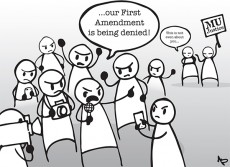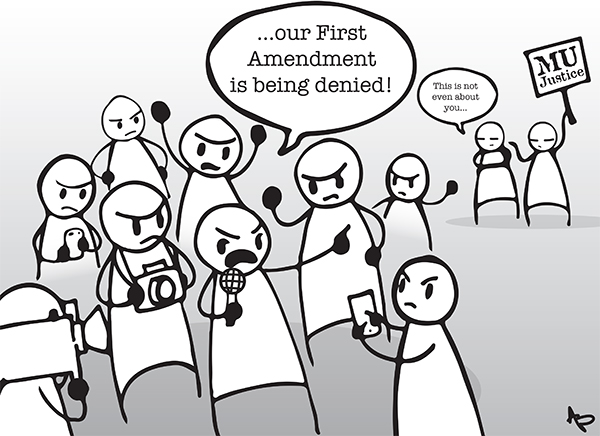Black students at the University of Missouri, no doubt like students at other universities, have long had to deal with a hostile environment that has made their academic experience a difficult one.
Students had been protesting with no media coverage for some time before football players threatened not to play if the university president did not resign. Suddenly, the actions and goals of this activist group became national news.

Due to protests over the racially charged environment on campus, which administration had largely turned a blind eye to, the university’s president and chancellor have stepped down from their positions.
Shortly after the president’s resignation was announced, the campus became the focus of another large discussion in the media about First Amendment rights.
At the center of this discussion is an approximately five-minute video filmed at the student protesters’ encampment depicting a group of protesters chanting and pushing a student journalist saying, “Hey hey, ho ho, reporters have got to go.”
What has largely been left out of this discussion, narrowly focused around five minutes in a monthlong protest over racial injustices inflicted on black students and professors for years previous, is the motivations of the protesters.
Students and faculty have been called the n-word, and several swastikas were painted on walls this semester. One such swastika was drawn with feces.
Black students, after these events, felt uncomfortable being on campus and were frustrated by the administration’s lack of action. That’s when they began protesting and came out with a list of demands.
Graduate student Jonathan Butler committed himself to a hunger strike until the president resigned.
“I already feel like campus is an unlivable space,” Butler told The Washington Post. “So it’s worth sacrificing something of this grave amount because I’m already not wanted here. I’m already not treated like I’m a human.”
Many people have called out the protesters claiming they are ignorant of First Amendment rights. But this judgment has been assessed only from what is seen in one five-minute video of protesters vehemently calling for reporters to back off.
While several individuals in this video, including a communications professor did behave poorly by calling for “muscle” to get rid of photographers, this does not necessarily represent the entire activist collective on campus.
Also, it is not unreasonable for protesters, particularly protesters of a racial minority, to fear being portrayed negatively or judgmentally by media outlets.
Americans’ trust in the media is at an all-time low.
This incident and the protesters’ decision to limit contact with the media has divided this issue and brought significant attention away from what protesters stand for to instead discuss First Amendment rights.
While it is crucial to focus on their reasons for protesting and also separately necessary to ensure citizens understand the First Amendment, what has not been given as much thought is why students of a racial minority might feel uncomfortable being the focus of the media.
Significant thought should be directed toward understanding why black students involved in the protests at MU felt threatened by the presence of journalists and reporters.

